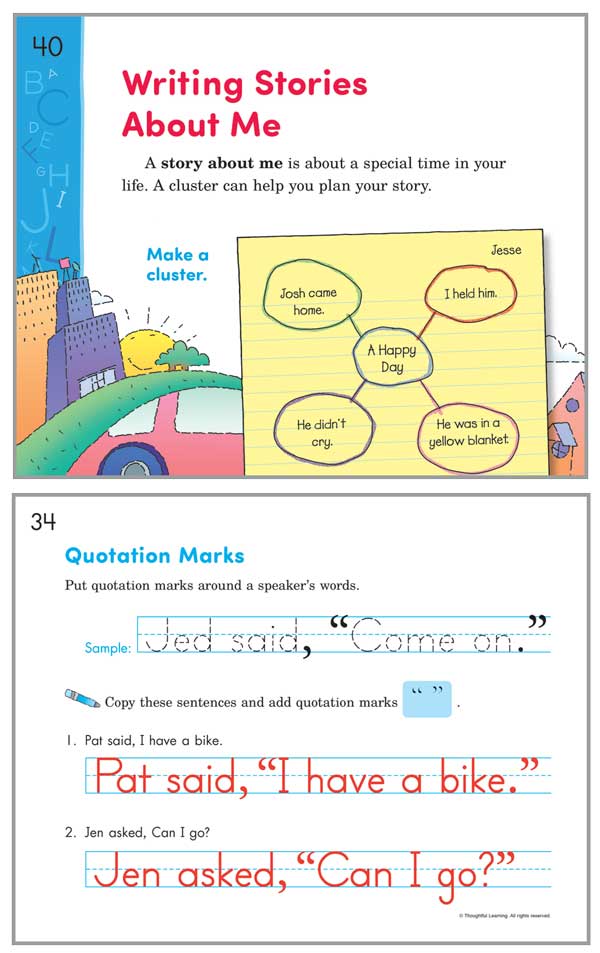How should I assess student writers?
You should use many different and flexible measures of student writing, from formative assessments of process to summative assessments of products.
- Observe writers at work, noticing enthusiasm, diligence, care, creativity, neatness, and so on.
- Interact with students throughout the process, informally discussing their work, engaging in small-group discussions, and conducting student/teacher conferences.
- Analyze students' finished products, highlighting particular strengths, making suggestions for upcoming assignments, and giving grades.
For more on formative and summative assessment, see "Assessing Student Writing."
Should I grade all student writing?
No. For example, you should not grade prewriting activities or writing-to-learn activities like taking notes. Students need the freedom to use writing to organize their thinking. Also, you should not give letter grades to journals, but only marks to indicate how much journal writing students are doing. Journals are all about quantity--helping students produce many ideas routinely and thereby gain writing fluency.
Reserve summative assessment for more formal writing projects. And when you do provide a grade at the end of a project, make sure to provide plenty of formative assessment throughout the process. Quarter or semester grading ought to reflect a measurement of each student’s progress as a language learner—as much as, or even more than, the quality of the end products.

How should I teach grammar and punctuation?
Study after study has shown that grammar skills should not be taught in isolation. Students drill and forget unless the new skill is immediately applied to meaningful writing that students are doing. When students can see that correct capitalization or punctuation makes their writing more effective, they internalize the conventions.
Integrate skills instruction with the regular writing that students do in your class. When students are working on "Stories About Me," for example, you can also have them complete the SkillBook activity about using quotation marks. After they complete the activity, tell students, "In your 'Stories About Me,' you need to use quotation marks around the words that people speak." Then, as you provide formative and summative assessment, help students find any errors. As students move to the next writing assignment, tell them they need to continue to use quotation marks around words that people speak, but also add a new skill that they will need to demonstrate.
How can I help students who struggle with correctness?
If a student or a group of students struggles with a specific aspect of conventions, you can do a number of things:
- First note the error, showing why it is incorrect.
- Then review the rule in the Write One student handbook.
- Model how to spot and correct the error.
- Provide practice from the SkillsBook and from handouts in the Teacher's Guide.
Let students know that you expect them to look for the problem in future writing assignments.
What about handwriting?
All students should work on their handwriting, improving legibility and fluency, but handwriting is not an end in itself. Handwriting is just one important aspect of expressing ideas clearly on paper. You can use the handwriting hints and models on pages 148-153 in the Write One student handbook to help students improve their legibility. The best way to improve fluency, however, is to have your students write routinely for many purposes. As their writing confidence grows, their handwriting will also improve.
Should I do all of the evaluating?
No. You should involve students as much as possible in assessing their own work and evaluating the work of peers.
- Have students use "Student Checklist," to revise and edit their own work for the key qualities of writing.
- Teach students to respond to others' writing with a "Peer Conference" sheet in a one-on-one peer response session. Also, have them participate in group conferences.
- Provide students with "Writing Rubric" so that they understand in advance what you will be looking for when you grade their work. As students become confident writers, invite the class to modify the rubric for future assignments, focusing on different aspects of structure, ideas, and conventions.
- Each time a student adds a work to a portfolio, have the child complete "For My Portfolio" to reflect on the writing they have done.
You can also involve parents in the evaluation process. For example, invite them to respond via email or in conferences to their child’s work, whether it be a series of daily assignments or a more important writing selection. Parents can also react to their child’s portfolio at the end of a grading period, ideally in a parent/teacher/child conference.